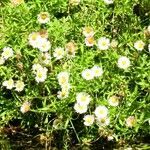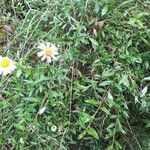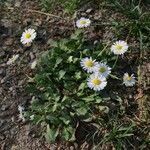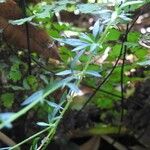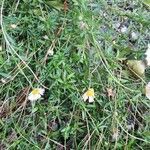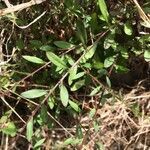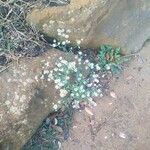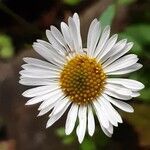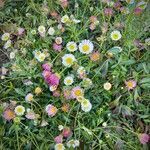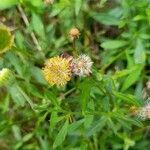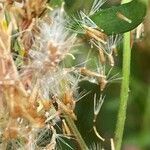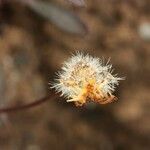Herbs, short-lived perennial, caespitose, [10-]15-40+[-100] cm tall; caudex short, simple or few branched, taprooted. Stems creeping or prostrate to ascending or erect, sometimes rooting at nodes, branched upward, sometimes with axillary leaf tufts, sparsely strigose to glabrate, eglandular. Leaves: basal and lower usually withered at anthesis, petiolate, petiole narrowly winged, blade elliptic or obovate; cauline shortly petiolate, elliptic to obovate or oblanceolate, 1-4 × 0.3-1.4 cm, even sized, surfaces sparsely strigose to glabrate, eglandular, base attenuate to cuneate, margin 2-4-lobed or entire, slightly revolute, strigose, apex acute or acuminate, mucronulate. Capitula 1 or 2[-5] at ends of upper branches, 5-7 × 10-13 mm. Involucre campanulate; phyllaries 3-or 4-seriate, membranous, linear to lanceolate, 1.5-3.3 × 0.3-0.6 mm, sparsely strigose, apex acuminate, outer slightly shorter, green along midvein, inner margin narrowly scarious, erose. Ray florets female, 1-or 2-seriate, 45-80, 6-8 mm, tube 1-1.5 mm, lamina flat or slightly coiling, white, sometimes pinkish upon drying, linear, ca. 5 × 0.6 mm, 2-denticulate at apex, glabrous; disk florets bisexual, yellow, narrowly funnelform, tube ca. 2 mm, sparsely hairy, veins orange, lobes glabrous, apex papillate. Achenes oblong, flattened, ca. 0.8 mm (immature), sparsely strigose, 2-veined. Pappus 2-seriate, outer of short setae, inner bristles 15-27, ca. 2.5 mm. Fl. Mar-Nov.
Perennial herb 30–75 cm long, procumbent and forming interlaced mats, but with erect flowering branches, stoloniferous (fide Lisowski), densely branched; stems often with a purple tinge, slender, slightly angled, sparsely pilose.. Leaves alternate or in axillary fascicles, sessile or with petioles to 3 mm long, the proximal leaves 3–5-lobed, with obtuse and mucronate lobes, more distal leaves narrowly elliptic, 0.5–3(–5) cm long, 0.3–1.5(–2) cm wide, cuneate at the base, margins entire or at most with 2 teeth, acute with a callous tip, sparsely pilose on both surfaces, glabrescent, 3-nerved from base.. Capitula terminal, usually solitary but occasionally in lax panicles of up to 5 heads, hemispheric, 7–8 mm long, 15–22 mm in diameter; peduncle to 9 cm long, glabrous proximally and becoming pubescent distally; phyllaries 50–80, subequal, lanceolate, 2–4 mm long, 0.3–0.5 mm wide, margins narrowly membranous and minutely serrulate, acuminate, sparsely pilose; receptacle flat or convex.. Ray florets 1-seriate, with cylindric tube, 1–1.5 mm long, rays white above, pink beneath, linear to oblanceolate, 5–6 mm long, 0.5–1 mm wide, obtuse, style 2.2 mm long; disc florets many, yellow, tube 1.5–2.5 mm long, lobes 0.3–0.5 mm long, anthers 1–1.3 mm long, style 2.5–3 mm long.. Achenes pale brown, ellipsoid, compressed, 1–1.5 mm long, pilose; pappus of white barbellate setae 1.5–3 mm long.. Fig. 101 (page 480).
Perennials, often short-lived , 10–100 cm; fibrous-or taprooted, caudices woody, usually simple, stems sometimes rooting adventitiously. Stems erect to sprawling or decumbent (small leaf tufts in axils of larger leaves), sparsely strigose to glabrate, eglandular. Leaves basal (and proximal cauline withering by flowering) and cauline; cauline blades elliptic to obovate, mostly 10–40(–50) × 5–13 mm, usually relatively even-sized along stems, margins entire or with 1–2 distal pairs of acute, mucronulate teeth or lobes, faces sparsely and loosely strigose to hirsuto-villous, eglandular. Heads 1–5 (usually from branches distal to midstem). Involucres 2.5–3.5 × 7–10 mm. Phyllaries in 3–4 series, sparsely strigose to hirsuto-villous or glabrate, sometimes minutely glandular. Ray florets 45–80; corollas 5–8 mm, laminae not or slightly coiling, white, sometimes drying pinkish. Disc corollas 2–3.1 mm. Cypselae 1–1.4 mm, 2-nerved, faces sparsely strigose; pappi: outer of setae, inner of 15–27 bristles. 2n = 18, 27, 36 (from Mexico, Central America, South America).
Procumbent to ascending perennial herb. Stems ridged, sparsely hairy, becoming glabrous, much-branched, rooting, 15-70 cm long. Lvs mostly or all cauline at flowering; lower cauline lvs ovate-elliptic to elliptic or obovate-elliptic, apetiolate and cuneate, cuspidate, often 3-lobed with central lobe largest, sometimes with lateral lobes reduced to teeth at c. 1/2 length of lf, sometimes entire, usually sparsely hairy, sometimes moderately hairy or almost glabrous, often ciliate, (10)-15-40-(60) × (2)-5-15-(25) mm; uppermost lvs smaller, narrow-elliptic, not lobed. Capitula c. 15-25 mm diam., solitary or few in corymbs. Involucral bracts lanceolate, glabrous or sparsely hairy, 2.5-4 mm long. Ligules linear, usually white flushed with purplish pink, sometimes white, pink, or purple, 5-8 mm long. Disc yellow or brownish yellow. Achenes sparsely hairy, 1-1.4 mm long; pappus of 1 row of long hairs, sometimes with shorter hairs intermixed.
A low-growing, well-branched perennial herb forming large tangled mats, stems thin (c. 1.5 mm diam.), prostrate, rooting and stoloniferous, the flowering ones erect, all leafy. Leaves often in axillary tufts, up to c. 30 x 5 mm, occasionally larger, narrowly elliptic, entire or toothed, tapering at both ends, they and the stems thinly hairy. Heads c. 1.5 cm across the expanded rays, solitary on long nude or sparsely bracteate peduncles terminating the branchlets. Involucral bracts in several series, linear subulate, thinly hairy, equalling the disc. Rays pinkish at first, later white, disc yellow. Achenes 1 mm long, elliptic, strongly compressed, pale brown, hispid. Pappus biseriate, of scabrid bristles.Flowers more or less the whole year round.
Prostrate perennial herb. Leaves narrowly elliptic, entire or toothed. Heads solitary on long nude or sparsely bracteate peduncles. Involucral bracts in several series, linear subulate. Flowers with rays pinkish at first, later white, disc yellow; October to February and in June.
